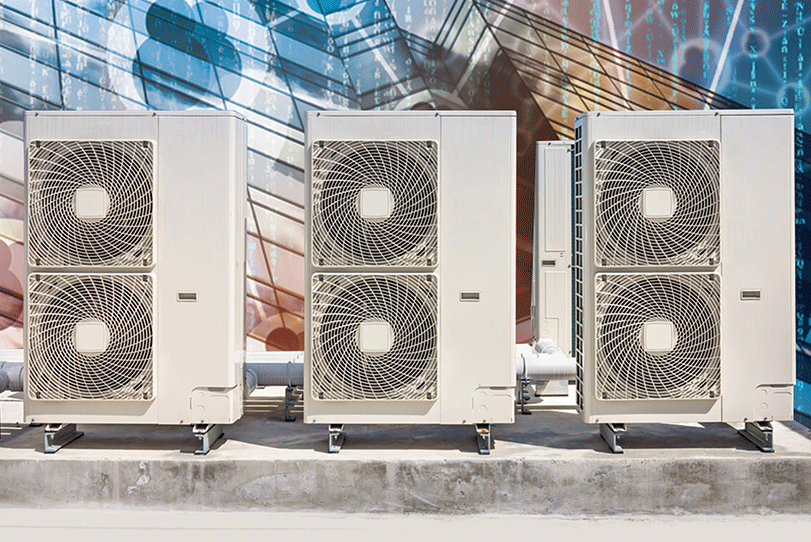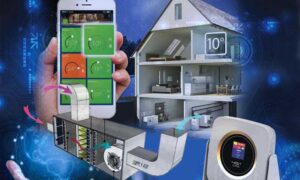An exclusive report on the points to be considered by HVAC professionals while designing the HVAC system of a building.
The main purpose of an HVAC system in a building is to provide ventilation, improve indoor air quality and enhance air conditioning and comfort. However, experts believe, there are various points to be considered by HVAC professionals while designing HVAC systems of a building to achieve the desired performance.
To begin, an air-conditioner performs to cool and dehumidify or keep heat and humidity inlet air to create a cold or warm airflow, which is blown into (supplied to) the room. Neeraj Gupta, Senior General Manager – Living Environment Division, Mitsubishi Electric India Pvt. Ltd. considers site location and orientation, building application, equipment efficiency, and air filtration, as some of the major factors.
System design factors (para)
Gupta recommends some of the system design factors while designing HVAC systems of a building as:
• Prevalent conditions: While working on any design of the HVAC system of the building, the actual condition of the building should be thoroughly analysed. The amount of usage of air conditioning and ventilation required for the building should be the criteria.
• Capacity of the equipment: The most important aspect is to determine the capacity of the equipment. Equipment capacity (TR) ≥ Heat load (TR)
• Calculation of heat load: The calculation gives an idea of the amount of heat energy required to maintain desired temperature and the amount of fresh needs to be circulated inside the room.
Heat Load (BTU/Hr) = Sensible Heat (BTU/hr) + Latent Heat (BTU/hr)
Sensible heat is a combination of solar heat gain, internal heat gains along with fresh air load whereas the latent heat is the addition of heat in the form of moisture from human being and from fresh air.
• Any specific request from customer: While finalising the design of the HVAC system, owner or customer request should be kept in consideration that can leverage them for a longer run.
Selection of model & equipment (para)
Gupta also feels selection of model and equipment plays a critical role. He explains:
• Air-conditioning load: It is essential to study the air-conditioning load – will the designed HVAC system able to provide comfort in the building. A thorough understanding should be made considering all the rooms in which cooling or heating is required.
• Electric power supply: Efficient electric power supply should be maintained.
• Installation location: The installation location for the HVAC system should be carefully examined.
• Noise: The noise level of the HVAC system should be controlled and ideally when an HVAC system is operating, sound levels should be barely detectable by occupants.
• Additional specifications: Check for any additional specification if it is required considering the building.
• Stand-by unit: Keep a standby unit ready for critical applications as it will be helpful during any system failure.
• Surroundings: Keep a regular check on the surroundings where the HVAC is installed.
Enhance energy efficiency (para)
An integrated HVAC system can enhance the energy efficiency levels of a building significantly. There are several factors that must be considered while designing HVAC systems for buildings to ensure the optimisation of energy efficiency.
Anuraaga Chandra, Head – Cooling Sales, Danfoss India lists some of the important points to be considered in order to achieve energy efficiency as:
• It is important to bear in mind the standards of ventilation to maintain indoor air quality. ASHRAE standards 62.1 and 62.2 are the widely accepted standards of ventilation to maintain acceptable indoor air quality.
• Zone control of HVAC systems refers to designing the system to help create customised temperature zones within the building to enhance comfort and efficiency.
• All cooling processes result in the generation of waste heat, which normally releases toxins into the atmosphere. There are several ways to capture the wasted heat and utilise it to reduce the energy input for heating processes. The most common method of heat recovery is the use of water or refrigerant based HVAC systems.
• At an operational level, it is prudent to use integrated and smart building management systems enabled with cutting edge technologies like IoT and predictive analytics. This enhances efficiencies and helps mitigate excessive costs for maintenance. For example, with the help of predictive analytics, it is possible to pre-empt maintenance of the HVAC system, thereby avoiding unnecessary delays and incurring additional costs.
• Use of eco-friendly refrigerant alternatives, etc.
Daniel Chen, APAC Marketing Manager (HVAC), CAREL recommends: “When designing an HVAC system, energy efficiency is the most important and indeed core issue. The energy requirements of buildings in the EU account for around 40 percent of total energy use.”
Today, most of our everyday lives are spent indoors, relying on mechanical heating and cooling, which means the most significant portion of energy consumption is attributable to air conditioning and climate control. As a result, any improvement in this area will be the main source of energy saving and consequently a reduction in building running costs, observes Daniel.
There are several ways to make HVAC systems more efficient, such as solutions for system integration, control and monitoring. The latest revisions to the Energy Performance of Buildings Directive (EPBD) by the European Commission are also clearly aimed at considering automation and control systems as key technologies for achieving an effective reduction in building energy consumption. “Not only is it important to lower the need for thermal energy, but it is also essential to identify the building’s profiles of use, in order to match the requirements of the building to those of the systems,” Daniel said.
Focus on sustainability (para)
Buildings have a significant impact on our environment. They can play a major role in mitigating climate change in the short- to medium-term since substantial reductions in emissions from their energy use can be achieved over the coming years. With HVACR being the biggest consumer of resources in a building, at a macro level, the MEP or HVAC professionals have to keep several aspects in mind to achieve sustainability, said Varun Pahwa, President, DRI – Pahwa Group. He adds, “The challenge is to build buildings smart, so they use a minimum of non-renewable energy, produce a minimum of pollution, and cost a minimum of energy rupees while increasing the comfort, health, and safety of the people who live and work in them.”
Pahwa recommends a few important points to be adhered during designing a new project or planning its renovation to achieve comfort and sustainability:
• Ensure quality IEQ through good design, construction, and operating and maintenance practices.
• Source local products to the maximum extent possible.
• Provide thermal comfort with minimum use of energy while maintaining IAQ.
• Design and ensure adequate levels of ventilation and outside air for acceptable indoor air quality.
• Prevent airborne bacteria, mold, and other fungi through building envelope design through HVAC systems.
• Use environment-friendly materials that do not emit pollutants.
• Pay attention to acoustic privacy and comfort.
• Control and eliminate odours through contaminant isolation and removal, and air purification systems.
• Integration natural with artificial light sources.
• Save water by recycling.
Optimise the demand of energy and water requirements (para)
MEP or HVAC professionals should design the system which optimises the demand of energy and water requirements, suggests Gaurav Mathur, Associate Vice President – Sales Development (Building Services) at Grundfos India. He said, “Technologies should be adopted to minimise the Life Cycle Cost (LCC) and Total Cost of Ownership (TCO) and not just focus on the initial purchase cost. Systems should be adaptive to the changing load conditions. Building performance modelling and simulations techniques should be deployed to optimise the system design. Pre-fabricated, modularised and standardised components can be incorporated in the design specifications to enhance the construction efficiency and productivity of the building.”
Best practices for achieving high-performance HVAC systems (para)
According to Neeraj Gupta of Mitsubishi Electric India, many building owners do not realise how an efficiently performing HVAC system can improve indoor comfort and be profitable for them. He explains some of the best practices for achieving high-performance of HVAC systems as under:
• Correct heat load calculation: The heat load is the amount of heat added or removed from a building to maintain the indoor temperature at desired levels. So, determining the correct calculation will help in controlling the heat load and provide more comfort.
• Capacity value corrected equipment selection: Equipment selection should be done on basis of heat load calculation. Equipment capacity should be equal to or more than the required load.
• Best & recommended installation practices: Consider the best available installation practices recommended by OEV for best performance and safety.
• Recommended equipment operation: It is recommended to operate the air conditioning system to get comfort temp., maintaining too low or too high temp consumes extra energy, which directly affects its performance.
• Periodic maintenance cycle: It is often said that most of the low performance in the HVAC system is reported due to inefficient maintenance cycle. It is advisable to follow the periodic maintenance cycle recommended by OEM for trouble-free experience.
Improving compressor reliability and performance (para)
In the last few years, many technologies have been introduced for HVAC systems that help comply with the latest regulatory requirements and reduce operating costs. According to Daniel Chen of CAREL, variable-speed compressors driven by inverters provide the best way to avoid inefficient on/off cycles that reduce compressor seasonal energy efficiency. “Compressors with permanent magnet motors controlled by DC inverters are the heart of the most efficient technologies available in the world for HVACR applications. Over the last few years, CAREL has been introducing this technology to HVAC applications, especially the most energy-hungry, such as heat pumps and air conditioners for data centres,” Daniel adds.
Electronic expansion valves save energy by adaptive optimisation of system parameters during operation. In particular, the system can operate with a lower pressure difference, allowing a more radical decrease in condensing temperature and reducing compressor power consumption, consequently lowering operating costs.
An advanced control and supervisory system with energy saving functions is particularly important, so as to adapt operation to the climatic conditions and the requirements of the end user.
With these technologies, power consumption can be reduced by up to 40 percent, while fine temperature control and constant control and optimisation of operating conditions can maximise compressor reliability and performance, claims Daniel.
Economical & good engineering solutions for good IEQ (para)
Green building practices offer an opportunity to create environmentally sound and resource-efficient buildings by using an integrated approach to design. Green buildings promote resource conservation, including energy efficiency, renewable energy, and water conservation features; consider environmental impacts and waste minimisation; create a healthy and comfortable environment; reduce operation and maintenance costs; and address issues such as historical preservation, access to public transportation and other community infrastructure systems.
With the IAQ, or rather IEQ, becoming increasingly important, HVAC professionals are always looking to integrate sustainable technologies and products for economical and good engineering solutions to provide a good IEQ, Varun Pahwa of DRI – Pahwa Group said.
IEQ encompasses indoor air quality, which focuses on airborne contaminants, as well as other health, safety, and comfort issues such as aesthetics, potable water surveillance, ergonomics, acoustics, lighting, and electromagnetic frequency levels. IEQ improvements to an existing building can occur at any point during the use of a building.
The entire life cycle of the building and its components is considered, as well as the economic and environmental impact and performance. “Fresh air, air purification systems, and energy recovery systems have come out as a winner providing cost-effective solutions to the problem especially in tropical countries like India having high latent loads,” Pahwa comments.
Smart pump for greater efficiency (para)
HVAC systems are undeniably one of the crucial factors for both residential as well as commercial buildings. With the India Cooling Action Plan, the government has worked towards ensuring that buildings are more energy-efficient and have an adequate ventilation system. Considering the consumption of about 40-50 percent energy by air conditioners, significant and rapid strides have been made towards bringing cutting-edge energy-efficient HVAC solutions by the industry. As the demands are changing with time, the industry is revolutionising and adapting the technological nuances to bring efficient and sustainable water solutions, said Gaurav Mathur of Grundfos India. He said, “This is going to be coupled with the demand for technology-centric solutions such as the Internet of Things (IoT) to automate the HVAC systems.”
Grundfos has been one of the frontrunners in the industry in transforming a conventional pump to an electrical pump and now a smart pump. Mathur said, “We invent and innovate highly efficient and sustainable HVAC systems and we contribute our competencies and experience with our customers. Through our modular approach, we have made it even broader. With a combination of modern technological and old-fashioned craftsmanship, we have designed solutions that provide savings up to 80 percent compared to conventional constant-speed pumps.”
Grundfos delivers both the expertise and the high-performance pumping systems to meet demands for energy savings, decreased lifecycle costs and increased comfort and convenience for end-customers. “Our fully integrated, all-in-one packaged systems are designed to meet changing capacity requirements with optimal efficiency in the HVAC industry,” Mathur informs.
HVAC beyond COVID-19 (para)
Since the outbreak of the novel coronavirus, where safety considerations have been paramount, a sound HVAC system has become ever so important. An integrated HVAC system with the right air filters, fresh air intake etc. can enhance safety through ventilation systems and reduce the probability of carrying airborne contaminants through recirculated air brought in by movement of people. It can also help control and maintain indoor air quality, while delivering indoor comforts as well.
According to Anuraaga Chandra of Danfoss India, “Among the most important attributes of an integrated HVAC system, is that it can go a long way in reducing carbon emissions, especially in commercial and residential buildings, as cooling comprises nearly 50 percent of a building’s energy use.”
While the sector has traditionally been considered a ‘dirty business’ as it consumes a lot of chemicals and releases waste heat into the environment, going forward, Chandra suggests, the ‘new normal’ must be driven by decarbonising the industry enabling and initiating a ‘green restart’ of the economy. “The HVAC industry has great potential to become India’s next ‘sunrise’ industry, making it a value creator, rather than an environment disruptor,” he avers.
Chandra also believes that the digital transformation of the HVAC industry will be a key driving force in establishing a low-touch and low carbon industry in the new world order. These include integrated building management systems, connected devices, enabling of remote management capabilities. Going forward, digitalisation will likely also impact service delivery and sales models, he concludes.
Many building owners do not realise how an efficiently performing HVAC system can improve indoor comfort and be profitable for them.
Neeraj Gupta, Senior General Manager – Living Environment Division, Mitsubishi Electric India Pvt. Ltd.
MEP or HVAC professionals should design the system which optimises the demand of energy and water requirements.
Gaurav Mathur, AVP – Sales Development (Building Services), Grundfos India
When designing an HVAC system, energy efficiency is the most important and indeed core issue.
Daniel Chen, APAC Marketing Manager (HVAC), CAREL
The HVAC industry has great potential to become India’s next ‘sunrise’ industry, making it a value creator, rather than an environment disruptor.
Anuraaga Chandra, Head – Cooling Sales, Danfoss India
With the IAQ, or rather IEQ, becoming increasingly important, HVAC professionals are always looking to integrate sustainable technologies and products for economical and good engineering solutions to provide a good IEQ.
Varun Pahwa, President, DRI – Pahwa Group
Cookie Consent
We use cookies to personalize your experience. By continuing to visit this website you agree to our Terms & Conditions, Privacy Policy and Cookie Policy.















